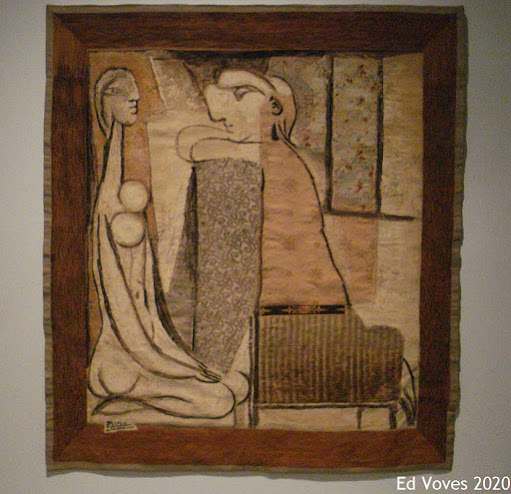
Tapestry version Picasso’s “Secrets (Confidences),” 1934.
Image courtesy of: Art Eyewitness, photographed by: Ed Voves
Perhaps it is Marie Cutolli who we can thank for pioneering “artist-designed” rugs? The Paris-based gallery owner was instrumental in helping to promote rugs that were made in conjunction with some of Modernism’s most well-known artists.
Beginning in the 1920’s, Cutolli commissioned artwork for Jean Lurcat, Pablo Picasso, Louis Marcoussis, and Fernand Leger. She took this artwork to Algerian weaving workshops and had the designs made into pile rugs. The following decade, Cutolli reached out to Joan Miro, Le Corbusier, and Pablo Picasso (again) for new designs which were translated into tapestries woven in some of the most fabled workshops of Aubusson, France. What resulted were amazing limited-edition pieces that are monumental in size.
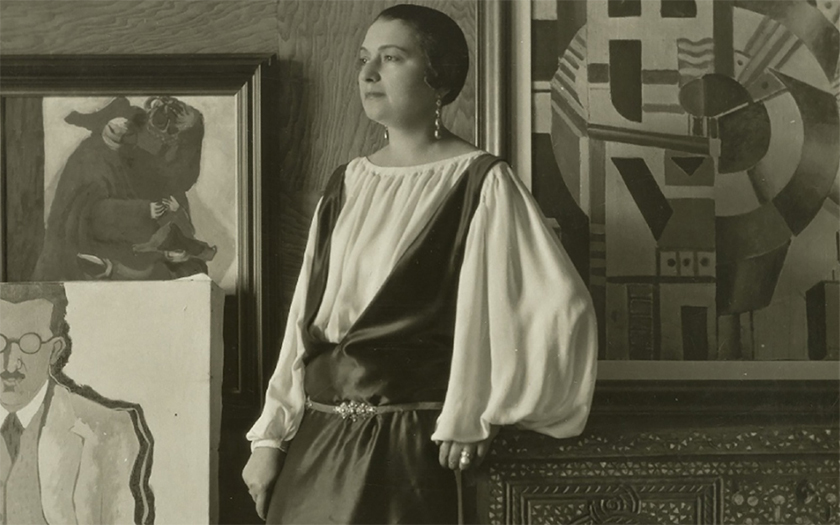
In 1926, Cuttoli stands in front of a Fernand Leger tapestry in her Paris store, Maison Myrbor.
Image courtesy of: France Amerique, photographed by: Thérèse Bonney
For the Algerian-born Cuttoli, her original interests lay in reviving carpet production in Algeria. In 1910, the entrepreneur set up a workshop in her Algerian home to teach the local women the trade. The work they produced was sold to some of Paris’ biggest haute couture houses. When she opened up her gallery, Maison Myrbor, a design house and gallery in Paris, Cuttoli started to commission tapestries by some of the time’s most famous artists.
Cindy Kang, a Barns curator was quoted in describing Cuttoli that she probably planned on a career in couture fashion in Algeria, but “she discovered the beauty and craftsmanship of its embroidery and weaving and realized that there as a European market for this work.”
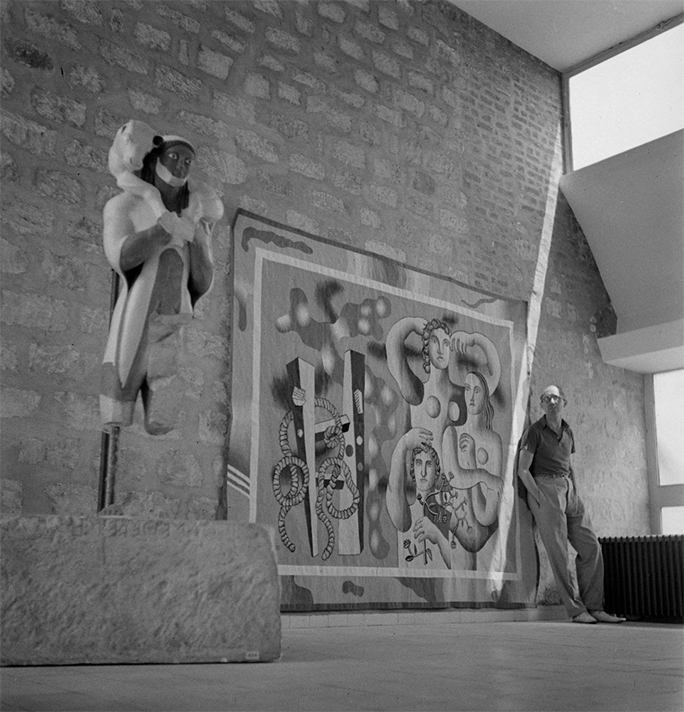
In Paris, Le Corbusier in front of a Fernand Leger tapestry, “Composition aux trios figures, Retour de Grece.”
Image courtesy of: France Amerique, photographed by: Thérèse Bonney
Cuttoli’s “art project” was driven by her desire to help the struggling weaving industry and the workers impacted by its slow demise. It was a 1939 exhibition of tapestries and modernist objects that Cuttoli loaned the San Francisco Museum of Art that attracted ten million visitors… an enormous number for those days. The exhibition was scheduled to run for several months, however the start of World War II prompted the boarders to close and the exhibit was changed to become a domestic touring show. Cuttoli herself became a sort of “ambassador of French and European culture in the United States.” She offered artists new ways to connect with an audience previously uninformed about their work.
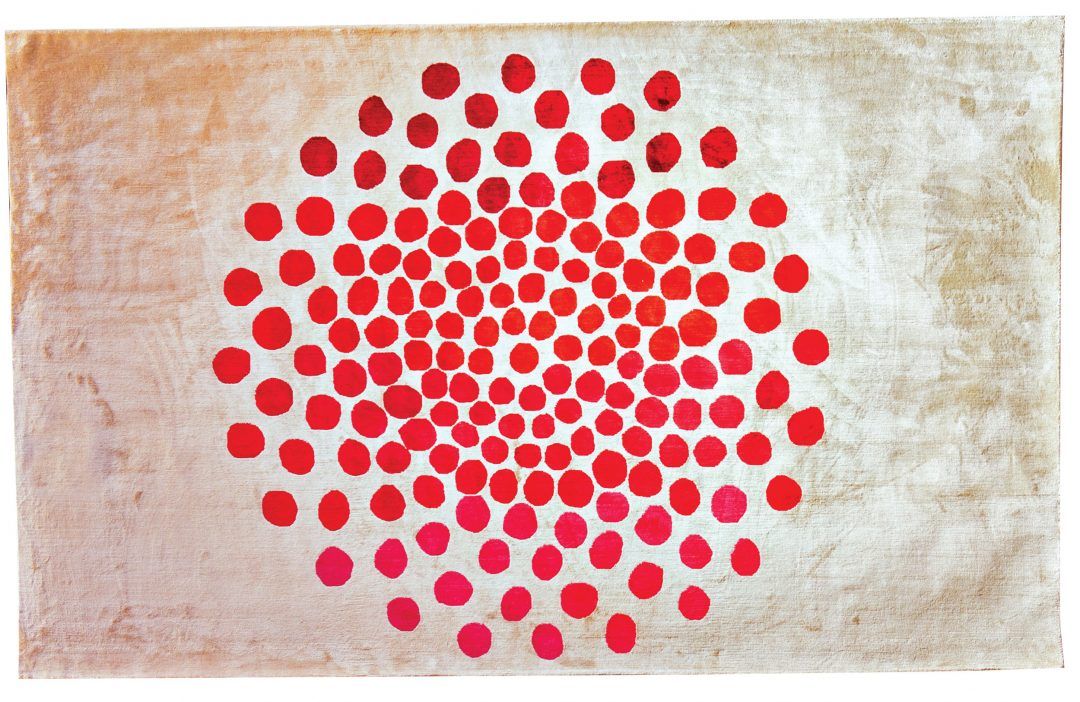
Sabine de Gunzburg’s silk rug resembles a Yayoi Kusama or Damien Hirst work.
Image courtesy of: Galerie Magazine
Today, artist-designed rugs continue to blur the line between art and design. The cross-disciplinary collaboration is one that has a long and storied history. Nadder Bolour, owner of Doris Leslie Blau told Galerie Magazine, “In a changing world where art and design are coming together more than ever, our new collection of Art Deco-inspired rugs really reflects this. Also, these pieces take so much time and skill to produce, they truly should be considered world of art no matter how they are used.”
The Rug Company collaborates with of the world’s most inspiring and respected designers in the fields of print, fashion, art, interior or product design, and architecture. Among those are: Vivienne Westwood, Kelly Wearstler, Alexander McQueen, and Paul Smith. Working together, the two entities are able to translate a creative brilliance to a gorgeous rug.
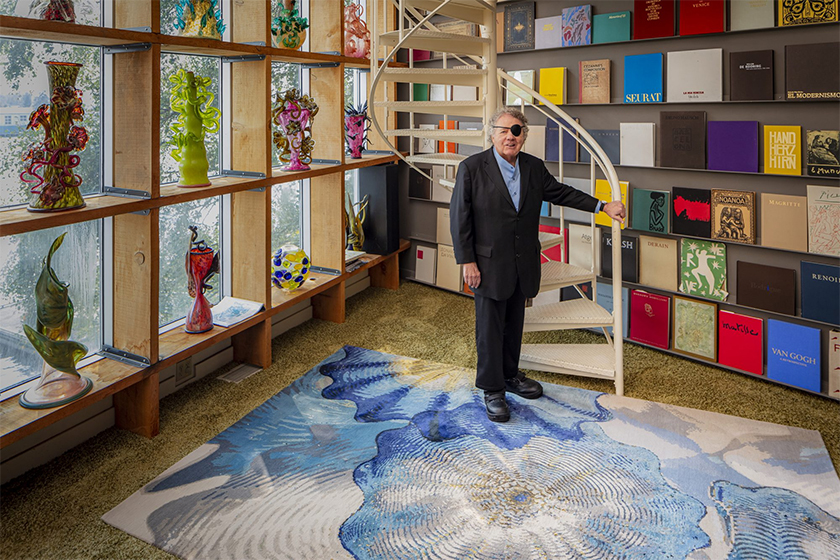
Chihuly loves the Rosette design, a rug that was inspired by the Persian series of flowering glass orbs. He says, “Those familiar with my work will recognize the organic, irregular shapes layered over one another to create a sort of illusion of transparency.”
Image courtesy of: Southern Living, photographed by: Nathaniel Willson
The Rug Collection’s designs with Dale Chihuly, the Seattle-based glass master, are especially inspirational. Together, the two collaborated to produce a collection of five rugs. Doing this was a no-brainer for Chihuly; he told Architectural Digest PRO, “Since my college days of weaving textiles, I have long appreciated the talent involved in creating objects of such lasting beauty and functionality.” The collector of Native American blankets was more then keen on this project from Day One.
One key obstacle was being able to translate the “see-thoroughness” of Chihuly’s glass pieces. Abby Olson, U.S. studio director said, “The biggest challenge proved capturing the translucency, reflections, and shadows of the glass objects.” Ensuring that the correct colors were chosen and the right mix of fiber types was selected were what produced such an amazing final project. Gorgeous indeed!